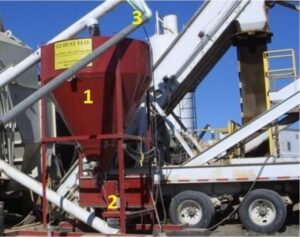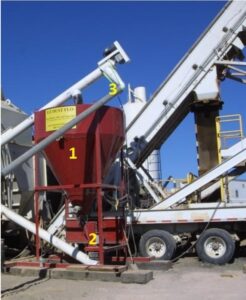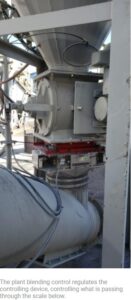BY CLARENCE RICHARD

The father-son team of Lloyd and Jason Vivant ran the plant for McNamara Contracting in Rosemount, Minnesota, 25 years ago. Lloyd wanted to control the amount of dust going back to his mix evenly and reject the difference. He set up a system to do just that.
Today, the system design still works well for Jay. The size of the bin has increased to take on unwashed material. The savings from not washing material is threefold:
- Cost of washing is abated;
- Plant production rates are increased with drier material; and
- Energy use decreases with drier material.
Because the minus 200 dust product may vary excessively at times, this can be an ideal opportunity to reject the excess. Let’s look at how you might do this at your facility.
The aggregate drying process inherently separates the fines from the on-spec material. When air velocity changes, whether that’s due to production, moisture or temperature variations, through the dryer, so does the size and amount of fines separated. Consequently, the loading of the baghouse changes and so does the amount of dust returned.
Complicating the issue further is the baghouse discharging the dust in sags and surges, which can be as high as plus or minus 21% over a three-minute period. Adding insult to injury, the hot stops allow the bags to relax when the fan is turned off causing most of the dust to fall and fill the auger below. When the plant is started again, the dryer initially sees the full auger surge (+59%).
Because the bags had released most of their dust, the augers run empty until the bags build up the dust cake again. This situation then causes the dust to go from the surge to a sag (-59%) until it slowly builds up the dust cake over a five-minute period.
There are some basic steps the plant operator must execute to ensure he isn’t chasing ghosts and is getting the correct fines metered back to the drum. Let’s look at those steps.
- Practice correct operating procedures, which involve slowly changing from one production rate—or temperature—to another, maintaining consistent aggregate moistures, and slowly changing exhaust damper or fan speed settings.

- Invest in the right equipment, such as a surge bin with flow measuring and control. You want the baghouse dust to be continuously fed to the surge bin (indicated by the number 1 in the photo). In order to use all the dust while smoothing all the sags and surges, the operator will set his vane feeder discharge speed so the level fluctuates between the low and middle-level bindicators during normal operation and between the lower and high-level bindicators during a hot start. Notice the change in bin-level tolerance is significantly different between steady production and startups; startups can take the system five minutes to recover. It’s that five minutes of dust that forces us to use the extra volume available in the storage bin. The surge bin should be sized to absorb these fluctuations. When rejecting dust, the operator can set the dust flow controller to the percentage wanted. The flow scale (indicated by the number 2 in the photo), reports to the controller and increases or decreases the vane feeder depending on the plant rate. The excess fills the surge bin and is rejected out the second surge bin auger discharge port.
These systems usually are added as a retrofit. The gray vertical picture below shows the controlling device to be regulated by the plant blending control by what is passing through the scale below. Owners should specify the control scheme they want their blend control to respond to. The author suggests the procedure below to get the full benefit from the new equipment. Remember, the control mode position switch has three options: feed/reject; sag/surge; and manual.


Mode 1. Reject Excess Dust
In Mode 1, the dust bin with an auger dust spillover, the discharge port is used to automatically reject what the vane feeder does not take away (i.e., the dust the plant does not use as a percentage of dust being added to the mix). The vane feeder is controlled by the plant blending computer in a closed-loop PID type control to setpoint percentage of material delivered to the drum as measured by the rate of flow through the continuous weigh scale. If this mode is selected and the percentage is set too high, some of the sags and surges will pass through. Upon hot start, the blending control should “remember” what the speed was when hot stopped and held for preset time for major surge-sag to pass and then release to PID control. (Upon hot stop, the bags usually release much of the dust held up in bags when fan airflow is stopped, and this fills the bottom augers. It will take the bags another baghouse cycle time to recharge the bags.)
Mode 2. Sag/Surge Control
In Mode 2, the speed of the vane feeder is based on finding the average speed it takes to keep the level of the bin as close to mid-level as possible (at least to keep from reaching high or low levels). If you experience a high-level bindicator (dry contact closure) reading, the speed signal should increase (preset adjustable speed up signal). Low-level bindicator (dry contact closure) should slow the speed signal down (preset adjustable speed down signal). Mid-level bindicator (dry contact) should give the operator an idea of how fast the bin is filling or emptying to help in setting where preset adjustable speeds should be set.
Mode 3. Manual Control
In Mode 3, the operator adjusts the speed as he sees fit. Unfortunately, operators usually set the vane feeder to keep the bin near empty, which defeats the purpose of all this equipment. For controlling surges, set the speed so the bin does not run empty and minimizes the time the bin is rejecting. When rejecting, feed the plant what it needs and everything else takes care of itself.
Dust should be controlled as closely as cold feed bins, and in some cases more closely. This is a great system to improve your mix quality.
For more information, contact Clarence Richard at (612) 590-0993